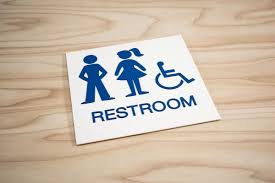Table of Contents
- Introduction to ADA Restroom Signs
- Public Facilities and Government Buildings
- Educational Institutions
- Healthcare Facilities
- Corporate Offices and Workplaces
- Retail Stores and Shopping Malls
- Entertainment Venues and Sports Arenas
- Hospitality Industry
- Community Centers and Religious Institutions
- Conclusion
Introduction to ADA Restroom Signs
ADA restroom signs are crucial in creating accessible public spaces for everyone, including individuals with disabilities. With standards set by the Americans with Disabilities Act (ADA), these signs ensure that restrooms are marked in easy-to-locate and understandable ways. Implementing ADA restroom signs helps meet legal obligations and promotes an inclusive environment. Ensuring that restroom signage is compliant is an essential step that demonstrates a commitment to accessibility, benefiting both businesses and the communities they serve.
Public Facilities and Government Buildings
One of the primary beneficiaries of ADA restroom signs is public facilities and government buildings. These places serve a diverse population, including people with varying disabilities. Utilizing compliant signage helps these institutions meet legal requirements while enhancing accessibility for all visitors. Public buildings clearly mark restrooms and ensure everyone can easily navigate the facility, regardless of their physical abilities. Moreover, ADA restroom signs contribute to a standardized approach to accessibility, reducing confusion and providing a welcoming environment for international visitors and those who may not be familiar with local languages or symbols.
Educational Institutions
Schools, colleges, and universities gain substantial advantages from ADA-compliant restroom signs. These signs, featuring tactile text, braille, and universally recognizable symbols, make navigating the often sprawling campuses much more accessible for everyone. On large, multi-building campuses, the clarity and accessibility of these signs are particularly beneficial. They help students and staff find restrooms easily and foster an inclusive environment by ensuring that facilities are accessible to all, regardless of physical abilities. This thoughtful approach to signage enables students with disabilities to focus on their academic pursuits without the added burden of searching for appropriate restrooms, thus enhancing their overall educational experience and promoting a welcoming and supportive atmosphere across the campus.
Healthcare Facilities
Hospitals, clinics, and other healthcare facilities must accommodate diverse patient needs. ADA restroom signs are crucial in these settings to ensure patients and visitors can quickly locate restrooms, particularly under stressful conditions. Clear and compliant restroom signs in healthcare settings contribute to reducing anxiety and stress for both patients and their families. In emergencies, easily identifiable restroom signs can make a significant difference in ensuring that patients and visitors can quickly and efficiently find the facilities they need. Furthermore, ADA signage in healthcare settings underscores these institutions’ commitment to providing compassionate, patient-centered care.
Corporate Offices and Workplaces
Employers are responsible for providing an accessible working environment. Implementing ADA restroom signs in corporate offices helps ensure that employees and visitors can easily find and use restroom facilities, regardless of their physical abilities. This fosters an inclusive workplace environment and demonstrates the company’s commitment to equal accessibility for all its employees. Providing accessible restrooms and clear signage can improve job satisfaction and productivity by reducing the barriers that employees with disabilities may face.
Retail Stores and Shopping Malls
Retail spaces and shopping malls serve a broad customer base, including people who may experience mobility issues. Installing ADA restroom signs in these locations ensures that all customers feel welcome and can comfortably access essential facilities. Proper signage shows that the business values all its customers, fostering a more inclusive shopping experience. In addition to enhancing customer satisfaction, compliant restroom signs can positively impact a business’s reputation. Retailers who prioritize accessibility demonstrate social responsibility, which can attract a loyal customer base and encourage repeat visits.
Entertainment Venues and Sports Arenas
Arenas, theaters, and other entertainment venues attract large crowds, including those with disabilities. ADA restroom signs are essential for these venues to ensure everyone can enjoy events without worrying about navigating basic facilities. Clear and accessible restroom signs enhance the overall experience, making events enjoyable for all attendees. Venues that prioritize accessibility create a more inclusive atmosphere, encouraging diverse audiences and helping to build a positive reputation in the community. Entertainment venues can guarantee all guests have a positive experience, regardless of their abilities, by displaying compliant restroom signage.
Hospitality Industry
Hotels, restaurants, and other hospitality businesses benefit from ADA restroom signs by making their premises accessible to all patrons. This not only complies with legal standards but also enhances the customer experience. Ensuring all guests can quickly locate restrooms fosters a welcoming atmosphere. Hospitality businesses prioritizing accessibility demonstrate their commitment to inclusivity, which can enhance customer satisfaction, improve reviews, and encourage repeat business.
Community Centers and Religious Institutions
Community centers and religious institutions often host a wide range of events that attract diverse groups of people. ADA restroom signs help ensure everyone can comfortably navigate these communal spaces, regardless of ability. Compliant restroom signage promotes inclusivity and shows that these institutions care for and welcome all community members. Providing accessible facilities, community centers, and religious institutions can ensure that their programs and events are open and accommodating to everyone. This inclusive approach helps build stronger, more connected communities where all members feel valued and respected.
Conclusion
In summary, ADA restroom signs benefit various facilities by ensuring accessibility and compliance with legal standards. From public buildings to private enterprises, installing these signs is a straightforward yet powerful way to create inclusive environments where everyone feels welcome. Prioritizing ADA-compliant restroom signage is vital in fostering inclusive communities and ensuring that all individuals can access and enjoy public and private spaces regardless of ability.





